
Andy Lloyd's Dark Star Blog

Blog 70 (January 2019)
Planet Nine - 3 Years on
There is no doubt that the scientific advocacy for a Planet X body has been significantly strengthened by the work of Brown and Batygin, who published their first paper about 'Planet Nine' three years ago (1). Mike Brown is a renowned astronomer in academic circles, whose speciality is hunting down distant Kuiper Belt Objects and dwarf planets in the outer solar system.
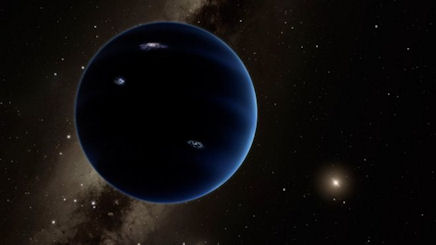
Image Credit: Caltech
Following on from the work of Trujillo and Sheppard (2), he and his Caltech colleague Konstantin Batygin studied odd similarities in the orbits of distant scattered disk objects (SDOs) which lie beyond the regular Kuiper belt. Certain orbital properties of these eschewed objects seemed to be gathered into place within a common clustering, and the astrophysicists determined that something massive located well beyond them must have been responsible for shepherding these objects into such a serendipitous arrangement. They advocated a renewed search for Planet X, which had been confined to the doldrums of astronomy for decades, and re-branded the object 'Planet Nine' (3).
Planet Nine is thought to be a super-Earth object, upwards of 10 Earth masses. Searches for exoplanets have determined that such planets are common enough elsewhere, but, so far as we know, absent from our own shores within this solar system. Planet Nine is likely twenty times further away from us than Pluto, maybe more, and how such an object could have ended up so far away from the rest of the planets has vexed scientists. Of course, it remains hypothetical, because, despite the observational strength of modern day astronomy, Planet Nine has not been located. Its position is unknown (beyond ruling out certain sections of the sky), as its existence can only be inferred from the clustering data, but not determined directly from it.
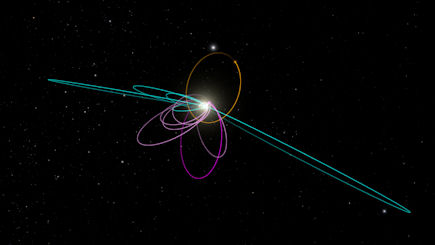
Image Credit: Caltech
Despite its 3-year long 'no-show', Brown and Batygin stand by their initial paper, and have published a follow-up paper this month to continue to argue their case (4). It primarily responds to the arguments raised by scientists working for the Outer Solar System Origins Survey (OSSOS) who found similar objects which did not seem to belong to the P9 cluster (5), and who went on to argue that the evidence for Planet Nine should be dismissed due to inherent observational bias in the data (6). At the time, Batygin quickly refuted that criticism, finding more patterns in the outer solar system snow, although I wondered whether the OSSOS data may be opening up another issue entirely about Planet Nine's argued-for position (7). Anyway, Brown and Batygin's new paper presents their subsequent work about the issue of observational bias, and offers a robust analysis leading to following conclusion:
"From this now more complete understanding of the biases, we calculate that the probability that these distant KBOs would be clustered as strongly as observed in both longitude of perihelion and in orbital pole position is only 0.2%. While explanations other than Planet Nine may someday be found, the statistical significance of this clustering is now difficult to discount." (4)
Having rebutted their critics on one front, the Caltech team face another problem this month, this time in the form of an alternative explanation for the clustering anomalies proposed by researchers from the University of Cambridge. This new hypothesis involves the possible existence of a very significant disk of objects beyond the Kuiper belt, with a combined mass of 10 Earth masses, or perhaps less. This massive ring of material would be eccentrically inclined to the invariant plane of the planets. The astrophysicists' calculations and simulations show that such a massive eccentric disk might have the gravitational pull to create the observed clustering of extreme SDOs (8), but the mass required represents a couple of orders of magnitude of mass greater than the known Kuiper belt. Arguing that studies of other young star systems show extended debris disks, the authors seem quietly confident about the potential existence of such a massive extended disk:
"“If you remove planet nine from the model and instead allow for lots of small objects scattered across a wide area, collective attractions between those objects could just as easily account for the eccentric orbits we see in some TNOs,” said [Antranik] Sefilian, who is a Gates Cambridge Scholar and a member of Darwin College." (9)
Brown points out that it's unusual in science for a new hypothesis - in this case the proposed existence of Planet Nine to explain the observed clustering of SDOs - to not face a barrage of counter-hypotheses. For some reason, all of the attention up until this point has been focussed upon the statistical credibility of the cluster properties. Brown acknowledges the new Cambridge paper is the first stab at an alternative explanation for the extended SDO cluster (11). In fact, a similar explanation has already been offered within academic circles, by a group based in Colorado led by Ann Marie Madigan last summer. The Colorado group argued that a significant amassed collection of distant asteroids could explain the observed anomalies (10). Mike Brown explains the difference between these two papers: "...although the hypotheses sound similar, they are really totally unrelated. The one from last summer doesn't actually explain...what we see. This one, at least, does." (12)
Despite actually offering what appears to be a mathematically credible explanation, Brown is sceptical of the new Cambridge paper on a couple of fronts: (1) The required mass of the disk (as above), and (2) its provenance (11). How could such a warped extended disk have been shaped in the first place? This raises another vexed question about how such a weird disk came to be, which flies in the face of the Cambridge authors' claim to have provided a simpler explanation than Planet Nine.

Credit: ESO/M. Kornmesser
It is known that the invariant plane of the planets is warped away from the solar equatorial plane by about 6-7 degrees. Planet Nine, on the other hand, is likely to be inclined by about 30 degrees, and may itself represent an explanation for this warping, should its mass be significant enough to have shaped the rest of the solar system in this way. As mentioned in the blog piece below ("Warped Protoplanetary Disks"), such warped arrangements are by no means confined to the solar system, and can appear very early on in the lifetime of a star system (13). What's less clear is why they arise. Some kind of distant, dark companion object pulling at the rest of the system seems a reasonable enough explanation - one that was already present, or co-forming, within the stellar birth cluster.
So, happy third birthday, Planet Nine! You may still be a mere twinkling in a Californian astronomer's eye, but you've already evoked a modern renaissance in the history of Planet X.
Written by Andy Lloyd,
24th January 2019
References
:1) Konstantin Batygin & Michael Brown "Evidence for a Distant Giant Planet in the Solar System" The Astronomical Journal, 151:2, 20 January 2016,
2) Chad Trujillo & Scott Sheppard "A Sedna-like body with a perihelion of 80 astronomical units" Nature, 27 March 2014, 507: 471-474,
3) Andy Lloyd "Massive Planet X Now Urgently Sought by Top Planet-Hunters" 20-23 January 2016,
andylloyd.org/darkstarblog34.htm
4) Michael Brown and Konstantin Batygin "Orbital Clustering in the Distant Solar System" The Astronomical Journal, 22 January 2019, 157(2)
5) Cory Shankman et al. “OSSOS VI. Striking Biases in the detection of large semimajor axis Trans-Neptunian Objects”, The Astronomical Journal, 154(2): 50, 14 July 2017
6) Josh Sokol “New haul of distant worlds casts doubt on Planet Nine”, 21 June 2017
7) Andy Lloyd "Planet Nine: Are They Digging in the Wrong Place?" 3 July 2017
andylloyd.org/darkstarblog52.htm
8) Antranik Sefilian and Jihad Touma. ‘Shepherding in a self-gravitating disk of trans-Neptunian objects.’ The Astronomical Journal 21 January 2019, 157(2)
9) Sarah Collins "Mystery orbits in outermost reaches of solar system not caused by ‘Planet Nine’, say researchers" 21 January 2019
10) Daniel Strain "Collective gravity, not Planet Nine, may explain the orbits of 'detached objects'" 4 June 2018
11) Mike Brown "Is Planet Nine just a ring of icy bodies?" 22 January 2019
12) @plutokiller replying to @darkstarandy, 24 January 2019
13) RIKEN Press Release "Early protostar already has a warped disk" 1 January 2019,
Ultima Thule : A Tumbling Red Snowman
The phenomenally successful New Horizons mission has begun to send back images of the Kuiper Belt Object 2014 MU69, located some 4 billion miles away (1). Prior to the spacecraft's successful flyby, astronomers had collectively decided to give this remote 'classical cold' KBO the unofficial nickname 'Ultima Thule', after the mythical northern realm of obscure, perhaps even occult, European legend. By some coincidence, its more official categorisation as object 2014 MU69 similarly contains an allusion to a lost continent, this time that of Mu - the Pacific Ocean's equivalent of Atlantis. A random scrabble moment hitting the double word score. The legend of Ultima Thule itself goes back to Roman times, but for some reason was appropriated by the Nazis who derived the concept from 19th century occult notions of a northern Aryan homeland (2).
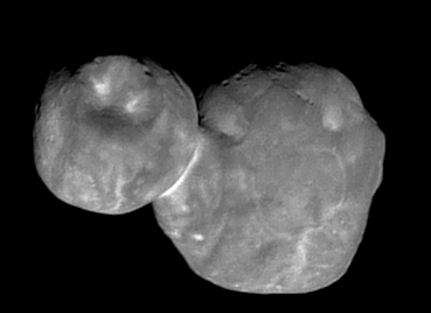
Image Credit: NASA/JHUAPL/SwRI
The celestial object (or pair of objects) known as 'Ultima Thule' is a mere 20 miles by 20 miles across, and appears to be shaped somewhat like a snowman falling head over tip. Behaving rather like the first interstellar object 'Oumuamua (3), discovered a couple of years ago, Ultima Thule is spinning end over end, like a slightly rotund tumbler. Its orientation explains one of the first mysteries about this object - why it showed no significant change in its light curve over time (4):
"Flyby data have already solved one of Ultima's mysteries, showing that the Kuiper Belt object is spinning like a propeller with the axis pointing approximately toward New Horizons. This explains why, in earlier images taken before Ultima was resolved, its brightness didn't appear to vary as it rotated. The team has still not determined the rotation period." (1)
1I/'Oumuamua was strange in other ways, though, particularly with how elongated it was, and its lack of obvious outgassing, despite the indirect evidence from its proper motion that it behaved like a comet (5).
What will be particularly interesting as more imagery is received and scientific data gained, is the composition and form of 2014 MU69. Knowing the likely ratio of the various frozen ices (methane, ammonia and water) to rock, for instance, may help to understand the nature of much larger objects in the Kuiper belt, particularly those which might be more reasonably considered to be dwarf planets. It is known that the cut-off point for objects to attain a spherical shape depends a lot upon their composition: asteroids mostly comprising of rock need to be at least 900 km across before this own gravity is sufficient to mould them into a ball. KBOs are thought to contain a lot more ice, which is more malleable, and so a roughly spherical shape may be attained at half that diameter (6). That has an implication for what size objects are likely to have to get to before they can be classified as 'dwarf planets' in the outer solar system. In turn, this will inform us of how many dwarf planets, similar to Pluto, are likely to be out there among the dispersed rubble of the Kuiper Belt.
Image Credit: NASA/JHUAPL/SwRI
Other questions which may be answered by New Horizons relate to the materials on the surface of this Kuiper Belt Object, specifically whether there is a presence of reddish frozen soups of organic materials. At the moment, the object appears to have a reddish tinge to it, suggestive, perhaps, or organics on its surface. A tumbling snowman covered in ketchup.
Evidence of cratering, or even refashioning, of the surface, may give clues to the collisional history and/or nature of geophysical activity within Ultima Thule. Again, this may provide clues about the historical dynamics of the Kuiper belt itself, and whether these objects originated in situ, or migrated from elsewhere early in the history of the solar system.
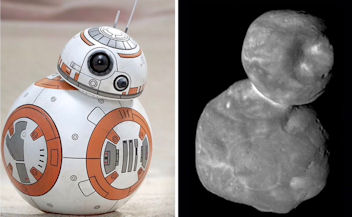
Now that we are starting to get a stronger impression of the actual shape of Ultima Thule, it's becoming clearer that it is a pair of objects which coalesced together and conjoined at the hip to create a 'contact binary' (7,8). This in itself is fascinating, as it shows how objects could have joined together in the outer solar system without creating catastrophic damage to one another. This may help us to appreciate how larger rocky structures took shape during the early solar system, as larger planetessimals formed out of the gentle merger of smaller ones. These kinds of 'bilobate' objects are not unknown in the solar system. A celebrated example is the comet that was closely studied by ESA's Rosetta spacecraft:
"...comet 67P/Churyumov–Gerasimenko is an accreted body of two distinct objects with ‘onion-like’ stratification, which formed before they merged. We conclude that gentle, low-velocity collisions occurred between two fully formed kilometre-sized cometesimals in the early stages of the Solar System. The notable structural similarities between the two lobes of comet 67P/Churyumov–Gerasimenko indicate that the early-forming cometesimals experienced similar primordial stratified accretion, even though they formed independently." (9)
It is generally thought that bilobate comets are primordial objects, due to the presence to highly volatile ices like nitrogen and carbon monoxide. But this is not necessarily the case. It is curious that this shape of Ultima Thule resembles the 'rubber duck' shape of a couple of famous comets (67P and Halley's), perhaps indicating a connection in terms of how these structures came to be - or even a common source of formation. It has been suggested that they could just as easily form within a debris field left over from catastrophic collisions of larger bodies - events which may have taken place at any time during the solar system's history:
"Catastrophic and marginally catastrophic collisions produce material straddling the limits of their mutual gravity, leading to low-speed mergers and a great variety of final shapes and sizes; this can account for what we observe in today’s cometary landscape. Clusters of fragments that initially separate at low speeds relative to each other coalesce during the gravitational phase into the next generation of comets... The eventual shape is often the result of two or more large transitory aggregates coming together and pressing into each other" (10).
Simulations to test this have shown that the cooler fragments of collisions tend to end up in the binding piles of debris, where the hotter bits get flung away. This kind of gravitational re-accumulation is reminiscent of the generally accepted theory about the formation of our Moon from collisional debris following an impact between Earth and a Mars-sized body, just on a much smaller scale. If many comets and, now, Kuiper Belt Objects, appear to be composites of collisional debris, then the implication is that a great deal of catastrophic activity has gone on in the outer solar system. This might explain why the Kuiper belt population is a fraction of what it should be. In which case, we should ask ourselves - what has been the driving force of all this cataclysmic activity? Is there something out there that's set such wheels in motion?
I'm convinced that creative processes of accretion are on-going in interstellar space (11), particularly centred upon the presence of substantial dark, free-floating planets - a topic I explore at length in my forthcoming book 'Darker Stars'. Either way, Ultima Thule's merged doublet (of 'Ultima' and 'Thule', apparently), held together by their mutual gravity, clearly demonstrates the process of creative accretion at work: An apparent lack of obvious craters on the surface, combined with the brighter appearance of materials around the 'neck' of Ultima Thule, are suggestive of predominantly accretion over collisional processes.
A better resolution image published on 24th January showed some craters in the day/night boundary, many depressions or pits, and what seem to me to be areas fused together within the structure (particularly at the 'neck), and maybe old craters which have been refashioned or filled in in some way. There are many clues here about how Kuiper Belt Objects formed. Higher resolution colour images are promised in the future, and 2014 MU69 looks like it will be giving up many of its secrets in the next few years.
As a final thought, maybe, given its Star Wars droid-like shape, the Minor Planet Center whould consider re-designating Ultima Thule as 2014 BB8?
Written by Andy Lloyd,
2nd-7th January 2019
References:
1) John Hopkins University Applied Physics Laboratory Press Release "New Horizons Successfully Explores Ultima Thule" 1 January 2019
2) Meghan Bartels "NASA named its next New Horizons target Ultima Thule, a mythical land with a Nazi connection "14 March 2018
3) Andy Lloyd "Alien Red Asteroid Crashes Through Solar System" 28 October 2017
andylloyd.org/darkstarblog55.htm
4) Andy Lloyd "Approaching Ultima Thule" 24 December 2018
andylloyd.org/darkstarblog69.htm
5) Andy Lloyd "Space Grease and Interstellar Objects" 30 June 2018
andylloyd.org/darkstarblog63.htm
6) Mike Brown "How many dwarf planets are there in the outer solar system?" 12 Nov 2018
7) Marcia Dunn "NASA: Icy object past Pluto looks like reddish snowman" 2 January 2019
8) "Where is New Horizons?"
9) M. Massironi, E. Simioni and J-B. Vincent "Two independent and primitive envelopes of the bilobate nucleus of comet 67P", Nature, 526: pp402–405
10) S. Schwartz et al. "Catastrophic disruptions as the origin of bilobate comets" Nature Astronomy, 2: pp379–382, thanks to Yun Zhang
11) Andy Lloyd "The Cumulative Effect of Intermittent Interstellar Medium Inundation Upon Objects In The Outer Solar System", Feb 2016, DOI: 10.13140/RG.2.1.5112.5526,
Warped Protoplanetary Disks
One of the several strands of evidence pointing towards the existence of a Planet Nine/X body is the ~6 degree tilt of the invariant plane of the planets away from the Sun's own equatorial plane. In other words, like the Earth, the Sun's axis is tilted away from the plane of the planets. All things being equal, the Sun and the planets should have formed out of a common rotating disk of primordial matter - the coalescing pre-solar nebula. It's understandable that many of the planets engaged in a bit of to-and-fro during the early period of planet-forming, and so ended up a little skewed. But the Sun is the dominant player, and it should take a considerable gravitational influence to draw the planets away from its own equatorial plane. Yet, the Sun is seemingly a lonely star. So, that pesky 6 degree tilt has to be explained by something. Maybe a passing star pulling at the planets at some point in the past; or maybe the Sun had an early companion (within its birthing dense core) which affected the system's alignment; or maybe another significant planet strongly inclined to the ecliptic, influencing the others over time (1).
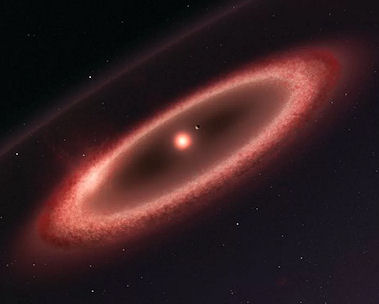
Studies of protoplanetary disks in young star systems is revealing similar warps elsewhere. The latest case concerns a very young single protostar system known as L1527. This system is so young that there is an implication that the warping may be occurring in the primordial cloud itself (2). The disk in question is effectively in two parts, where the warping issue affects the inner disc out to some 40-60 AU from the star (3). In the perceived absence of a companion object causing this effect, it is thought that the gravitational effect of the cloud itself is causing the warp in the protoplanetary disk.
But here's the thing: Just because there isn't a self-evident, luminous companion object near to L1527, doesn't mean that there isn't a darker companion lurking around somewhere nearby, tugging at the disk. It has been suggested that all stars begin life within dense cores, containing at least two protostars (4). In turn, this has implications about the potential for failed stars being ubiquitous companion objects (5). So, maybe L1527 does have an unseen sub-stellar companion affecting the structure of its inner disk.
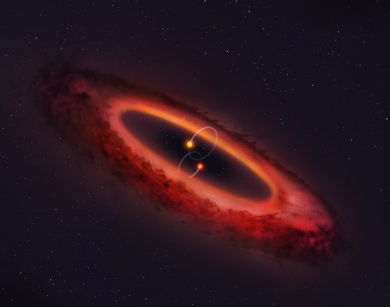
Another item of interest to add is news about another misaligned disk, this time around a young binary star system (6). In this case, the disk orbits at right angles to the orbit of the two stars which make up the binary HD 98800, meaning that the disk is in a perpendicular polar misalignment (7). Furthermore, the authors state that despite the extreme misalignment, the disk itself has physical properties similar to those around single stars, including, therefore, potential planet forming conditions.
Written by Andy Lloyd, 3rd January 2019
References:
1) Andy Lloyd "Does Planet Nine Solve the Riddle of the Sun’s Obliquity?" 30 July 2016
andylloyd.org/darkstarblog40.htm
2) RIKEN Press Release "Early protostar already has a warped disk" 1 January 2019,
riken.jp article3) Nami Sakai et al. "A warped disk around an infant protostar" Nature, 31 December 2018,
4) Sarah Sadavoy & Steven Stahler "Embedded Binaries and Their Dense Cores" MNRAS, 21 August 2017, 469(4): pp3881–3900
5) Andy Lloyd "The Sun was Born with a Companion" 15 June 2017
andylloyd.org/darkstarblog51.htm
6) Peter Thorley "Double star system flips planet-forming disk into pole position" 14 January 2019
7) Grant Kennedy et al. "A circumbinary protoplanetary disc in a polar configuration" 15 January 2019 Nature Astronomy Letters, with thanks to Lee nature.com article
Repeating Fast Radio Bursts
SETI has been hunting for alien life for decades, scanning the skies for
structured radio signals from space. They tend to look for signals
transmitted at certain wavelengths, and aim their search towards the
galactic centre to maximise the concentration of potentially habitable
star systems in view. There have been occasions in the past when
the odd signal was received, including the famous 'Wow!' signal, which
seemed to emerge suddenly from a fixed point in the sky, only to
disappear again (1). However remarkable this signal was 40 years
ago, nothing 'alien' could ever be proven based solely upon such a
single 'contact', no matter how aberrant. As with all scientific
enquiries, there needs to be a consistency in the phenomenon - a
predictability. The 'Wow!' candidate signal has never repeated,
and SETI have been left to continue their long-term search, thus far in
vain.
1I/'Oumuamua's hyperbolic handbrake turn. Image Credit:
Greg Laughlin #AAS233
However, since the turn of the century, a new series of candidate radio
signals have emerged to tantalise the extraterrestrial lobby. Fast
Radio Bursts are transient phenomena, lasting less than a second, whose
high-end energy output implies an origin within incredibly powerful
astrophysical events, like the merging of black holes or super-dense
neutron stars. The sixty 'FRBs' detected to date are located
randomly across the sky, rather than simply spread across the galactic
plane, and are therefore thought to reach us from distant galaxies
located billions of light years away. Like quasars before them,
the light from these objects may take billions of years to reach us,
moving through an intergalactic and interstellar environment which
leaves absorption traces in their red-shifted light spectrographs.
The nature of the light, and how the signal behaves during detection,
have allowed astronomers to rule out local sources.
In 2015, one of these bursts, 'FRB 121102', was found to have a
track-record of repeated emissions (the number is the inverted date of
discovery, so this burst was first detected on 2nd November 2012).
This seemed to discount the possibility that the phenomenon arose from a
singular event. The non-periodic nature of these repeated signals
also, potentially, puts it in the category of intelligently controlled.
Even serious academic astrophysicists have ventured an extraterrestrial
solution for FRBs (2), positing that these bursts may be
"leakage from planet-sized transmitters
powering interstellar probes in distant galaxies" (3).
Image Credit: M. Weiss/CfA
Curiously, the same idea - of spacecraft sails being propelled along by
light radiation - has also been proposed for the interstellar
asteroid/comet 1I/'Oumuamua, which executed a hyperbolic handbrake turn
through the solar system in 2017 (4):
"... 'Oumuamua
could in fact be a light sail, which was originally
proposed in another study by Prof. Loeb and Shmuel Bialy
(a postdoc research with the ITC). Basically, a light
sail is form of [sic]
spacecraft that relies on
radiation pressure to generate propulsion, which would
explain why the object sped up when moving away from the
sun." (5)
Returning to the FRBs, recently another repeated signal burst has been found for a different burst, this
time 'FRB 180814' (6). This second repeating FRB has again ignited
the debate over whether such a non-periodic but repetitive signal might
be of extraterrestrial origin (7). If so, then the energy output
from its source must be incredibly large for it to have travelled the
extragalactic distances involved to get to us. If they are
intelligent signals, then the aliens involved have gone to some
considerable 'expense' to create communication beams of such incredible
power. They would be well beyond what our civilisation is capable
of transmitting. Of course, that doesn't mean that intelligent
civilisations are not capable of such a feat - who knows what is truly
possible, given our nascent dabbling in galactic physics. But the FRB phenomenon seems more likely to be resolved in a similar way to the
early pulsars, which were themselves initially considered to be
extraterrestrial in origin.
Now, if only the 'Wow!' signal were to repeat... that would really set
the ET debate alight!
Written by Andy Lloyd, 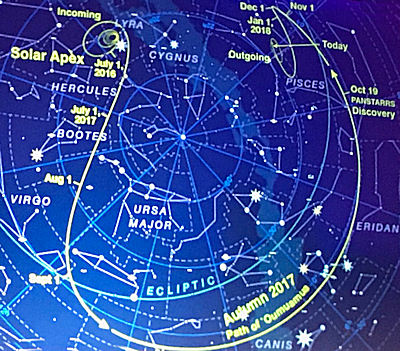
References:
1)
Seth Shostak "Happy Birthday WOW!" 15 August 20172) Manasvi Lingam & Abraham Loeb "Fast Radio Bursts from Extragalactic Light Sails" Astrophysical Journal Letters, 837(2)
3) Harvard-Smithsonian Center for Astrophysics Press Release "Could Fast Radio Bursts Be Powering Alien Probes?" 9 March 2017
4) Andy Lloyd ‘Oumuamua’s Many Cousins 21 January 2018
andylloyd.org/darkstarblog58.htm
5) Matt Williams "Interstellar Objects like Oumuamua Probably Crash into the Sun Every 30 Years or so and 2 Pass Within the Orbit of Mercury" 10 January 2019
6) The CHIME/FRB Collaboration "A second source of repeating fast radio bursts" Nature, 9 January 2019
7) Mattha Busby "Mysterious fast radio bursts from deep space ‘could be aliens’" 9 January 2019
Saturn's Rings
There has been some news this week confirming the relatively youthful age of Saturn's rings (1), based upon the publication of a science paper analysing data from the Cassini spacecraft (2). It has been suspected for a while that Saturn's majestic ring system has not been a permanent feature of the solar system. Observations by the Voyager spacecraft showed that the rings weighed very little, despite how immense they are compared to, say, the Earth. More recent studies carried out as the Cassini spacecraft manoeuvred between Saturn and its rings confirmed the low mass of the rings. That led astrophysicists to propose that the rings were formed somewhere between 10 -100 million years ago (3). That may have been due to a collision involving one of its moons, but there are issues with this, not least of which is an apparent lack of an obvious 'smoking gun' impactor in the solar system, in the form of a comet or Centaur with a Saturn-crossing orbit (4).
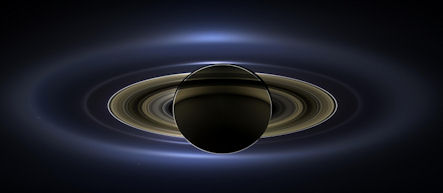
Image Credit: NASA/JPL-Caltech/SSI
So, an alternative is the capture of such a body into an orbit around Saturn, and its subsequent disintegration due to gravitational forces breaking the captured body apart (5,6).
Then there's the issue of how bright the rings are, given their low mass (total mass of the rings appears to be less than half the mass of the Saturn's moon Minas (2)). Their high reflectivity implies an icy composition which has not been significantly dampened over time by settling interplanetary dust.
"Cassini dust measurements have also provided a refined estimate of the interplanetary dust flux at the rings indicating that the interplanetary dust impact flux on the rings is higher by almost a factor of 10, compared to the Voyager estimates, due to improved understanding of the gravitational focusing by Saturn. These new dust fluxes are would [sic] reduce the age estimates for the A and B rings." (2)
I find this helpful for my own research into how sizeable planets might grow in size outside of the solar system, within interstellar space (7). The dynamics of dust accumulation within the solar system is different for that outside, due to the clearing action of the solar wind and drag forces pulling materials down into the Sun. In the case of dust influx in the vicinity of the planet Saturn, Cassini was able to measure the influx of dark interplanetary dust into the ring/moon system (8). This data shows the importance of this in-falling dust and materials, slowly darkening the icy shards orbiting Saturn within the rings.
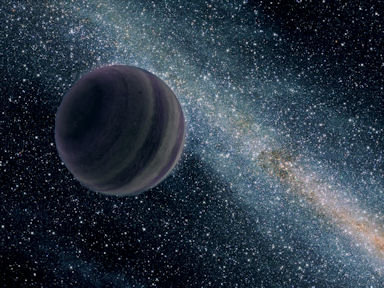
However, this situation is quite different from what is likely to be occurring outside the heliosphere, where exposure to dust within the interstellar medium is more dependent upon external factors - like the particular environment that the solar system is moving through within the galaxy at any given time, and the movement of the interstellar medium. This has repercussions for how planets outside a protective sheath like the heliosphere might continue to accumulate dust, gas and other materials around themselves over time.
This study of Saturn seems to show that more material is falling into the giant planet system than was previously thought, indicating the powerful attraction of planets as gravitational 'dust magnets'. In turn, this may hint at the kinds of processes occurring around, say, a Planet X body located well beyond the heliosphere. I would argue that these processes are, at least at times, taking place on a different scale completely, leading to planetary growth, and complexity. More in my new book, 'Darker Stars', due out shortly.
Written by Andy Lloyd,
20th January 2019References
:1) Chelsea Gohd "Cassini Reveals the Surprisingly Young Age of Saturn’s Rings" 17 January 2019
2) L. Iess et al. "Measurement and implications of Saturn’s gravity field and ring mass" Science, 364: 6445, 17 Jan 2019
3) Lisa Grossman "Saturn’s rings are surprisingly young and may be from shredded moons" 14 December 2017
4) Nadia Drake "Ringless Saturn? The Planet's Famous Feature May Be Surprisingly Young." 8 January 2018
nationalgeographic.co.uk article
5) L. Dones, "A recent cometary origin for Saturn’s rings?" Icarus, 1991, 92, 194–203, doi:10.1016/0019-1035(91)90045-U
6) H. C. Dones, C. B. Agnor & E. Asphaug "Formation of Saturn’s rings by tidal disruption of a centaur", Bulletin of the American Astronomical Society, 2007, 39, 7.07
7) Andy Lloyd "The Cumulative Effect of Intermittent Interstellar Medium Inundation Upon Objects In The Outer Solar System", Feb 2016, DOI: 10.13140/RG.2.1.5112.5526,
8) S. Kempf et al. "The Age of Saturn's Rings Constrained by the Meteoroid Flux Into the System" American Geophysical Union, Fall Meeting 2017
Images from the Far Side
The build-up to China's first successful probe to land on the Moon's surface was quiet. Perhaps they have made several attempts before, unsuccessfully. All the same, China's Chang'e-4 probe landed safely on the far side of the Moon on 2nd January 2019, and has sent back its first images from its new permanent home - the 180km wide Von Kármán crater (1).
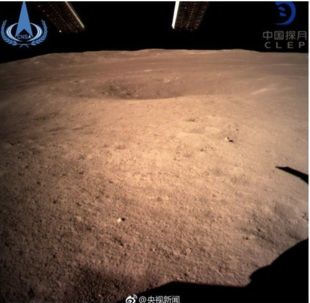
Image Credit: EPA/China National Space Administration
This ancient crater, named after Theodore von Kármán (the PhD advisor of the Chinese space programme's founder Qian Xuesen) lies within the broader South Pole-Aitken (SPA) Basin low down in the Moon's southern hemisphere. This massive basin is over 2500km across, and some 13km deep, and was likely caused by a colossal impact. Beyond its symbolic significance to the Chinese space programme, the von Kármán crater is ripe for some serious science: it is thought to be a promising location for sampling SPA-derived impact melt, the lower lunar crust and possibly upper mantle materials, too (2). After all, the depth of the ancient impact has revealed layers of the Moon, albeit partially filled back in by basalt. All this could help with a better understanding of the thermal evolution of the Moon. But the far side of the Moon is also an ideal location to conduct radio astronomy, as it is shielded from the radio noise from Earth. The Chinese lander also comes equipped with a spectrometer capable of detecting low-frequency radio waves, amongst other bits of useful science kit (1).
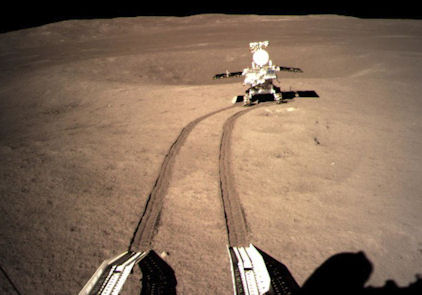
Image Credit: CNSA/Xinhua News Agency via AP
China can claim just credit for this amazing feat (it begs the question why the US et al haven't already done the same...). It is rare that landers have been sent to the Moon in recent decades - most ongoing exploration by various nations and agencies has involved orbiters and impact probes. None has attempted to land upon the far side of the Moon. Now constantly facing away from the Earth, the Chang'e-4 lander requires relayed transmissions through an orbiting satellite to send its information home. It really is nice, though, to see some 'modern' images of the Moon's surface, from the Moon's surface. We'll see more as time goes on, as the Chinese have managed to successfully drive their 'Jade Rabbit 2' rover off the lander's driveway, and onto the lunar surface (4). A previous soft landing by the Chinese in 2013 also involved a rover, 'Jade Rabbit', which unfortunately malfunctioned a couple of weeks later, so we'll have to wait and see how this goes (5), but so far everything's working as planned (6).
Questions I'm interested in concern the nature of the ancient collision,
and whether there is any water/water ice on or just below the lunar
surface within this deep crater (3). The
planned experiment to investigate
the interaction of the solar wind with the lunar surface hints at
the science to come.
Written by Andy Lloyd,
References:
1) BBC News "China Moon mission lands Chang'e-4 spacecraft on far side" 3rd January 2019
2) Z. Meng et al. “Landing site selection and prospective scientific objectives of von Kármán crater within south pole-Aitken basin”
3) Andy Lloyd "The Mysterious Origin of Lunar Water" 9th October 2014
andylloyd.org/darkstarblog19.htm
4) Reuters/CCTV "Chinese rover Jade Rabbit 2 sets off to explore far side of moon - video" 4 January 2019
5) Michael Martina "China 'lifts mysterious veil' by landing probe on far side of the moon" 3rd January 2019
6) AP "Chinese rover Jade Rabbit 2 powers up devices in pioneering moon mission" 5th January 2019
'From Mars to Sirius'
Ancient aliens make an appearance in French Death Metal gods Gojira's 2005 album 'From Mars to Sirius', which my son bought me for Christmas. I've been trying to decode it. There's lots about Dolphins and Whales from Space, which I guess loosely alludes to the Babylonian half-fish god 'Oannes' et al, described by Berossus, and the progenitor of the creation myth 'Enuma Elish' (1). The descriptions of planets/gods in Enuma Elish forms a substantial portion of Zecharia Sitchin's work on the Sumerian concept of 'Nibiru', which he proposed as a Planet X body (2).
Click on image to enlarge.
Image credit: Listenable Records, 2005
Here are some pertinent lyrics from the album, which seems to hint at Sitchin's Anunnaki:
"Four hundred thousand years ago/ They came from outer space/and gave us life here." (From 'Global Warming', Joe Duplantier, 2005)
There are hints of further Sitchinesque mythology in other lyrics (e.g. the Babylonian watery monster planet Tiamat in 'Ocean Planet', which is struck by lightning, and breaks apart). However, the artwork is less clear about such a link, given that there is a depiction of a nine planet solar system, emphasising Mars, with an flight trajectory drawn over towards the Sirius system, particularly Sirius C, a putative companion dwarf within the Sirius system. The writer of the lyrics, frontman Joe Duplantier, says the following about his Mars/Sirius connection:
“In some cultures, Mars symbolizes war and Sirius peace. I’m simplifying! It is a journey of a state of war, even if in France we are preserved, but it can be a war within us, in our flesh, in our mind, a war with ourselves.” (3)
Well, that may be true, but I think Duplantier's moving into deeper esoteric lore with some of these lyrics! Again, here are some relevant lyrics, from another song on the album:
"I come to Sirius C/ To learn from you friends of old...There is no goal to reach now/ Leviathans/ No complaint at all/ Dolphins from outer space/ Are in front of me/ In present they dwell." (From 'To Sirius', Joe Duplantier, 2005)
The Sirius C connection appears to be with Robert Temple's 'Sirius Mystery' (4), alluding to the Nommo, ancestral spirits worshipped by the Dogon people of Mali. Again, the allusion to space gods, as the 'secret knowledge' of the Dogon about Sirius appears to have included a hidden binary star, now known to astronomers. The companion star, Sirius B, is a white dwarf star which orbits around the much brighter white star Sirius A every ~50 years. To become a white dwarf, it must have first gone through a 'red giant' phase, which would have blasted away any nearby planets. Curiously, many of the ancients described Sirius as a red star (this is part of the 'red Sirius' anomaly'), which on the face of it seems to link to the red giant phase, although the timings would be, frankly, pretty weird as Sirius B collapsed into a white dwarf some 120 million years ago! I wrote all about this some years back... (5)
Sirius C has never been discovered, but I would suggest that if it does exist, then it's a wide orbit cold brown dwarf, or sub-brown dwarf. It would likely have its own habitable satellite planet, which the Dogon knew as 'Nyan Tolo'.
Anyway, I was particularly impressed with the ancient alien-oriented scribble inside Gojira's CD, which seems to include enigmatic allusions to Akkadian and Egyptian textual references. The music's not for the faint-hearted, though...so be warned if you decide to investigate the album further!!
Written by Andy Lloyd, 14th January 2019
References:
1) Enuma Elish: The Epic of Creation
2) Zecharia Sitchin "The Twelfth Planet" Avon, 1976
3) 'From Mars to Sirius' by Gojira
'From Mars to Sirius'
4) Robert Temple "The Sirius Mystery" St Martin's Press 1976
5) Andy Lloyd "The Dogon Tribe" 2001

You can keep informed of updates by following me on Twitter:
![]()
Or like my Facebook Page: https://www.facebook.com/darkstarandylloyd